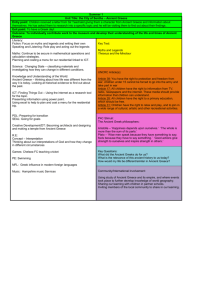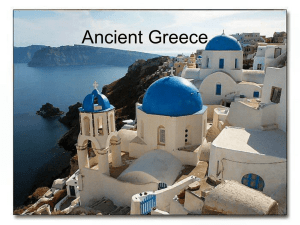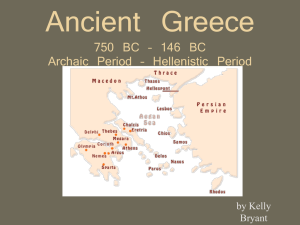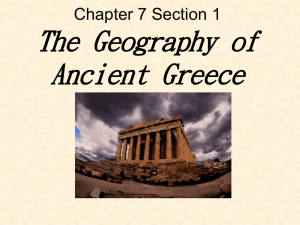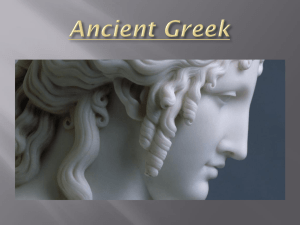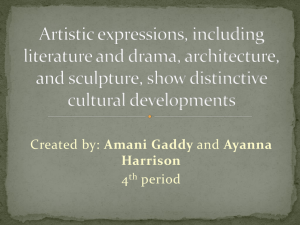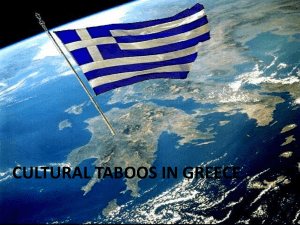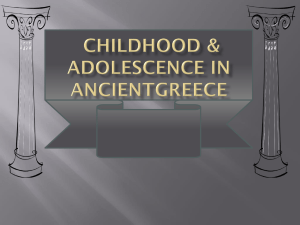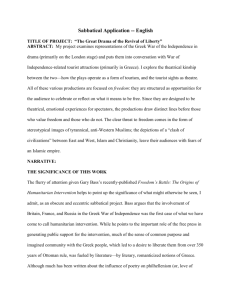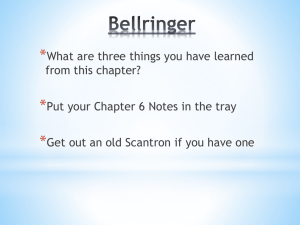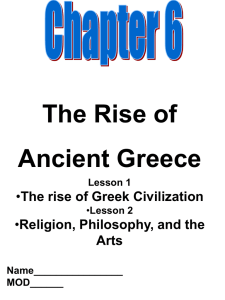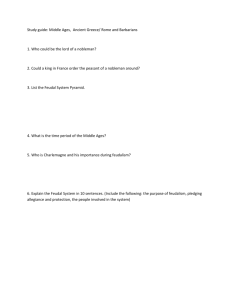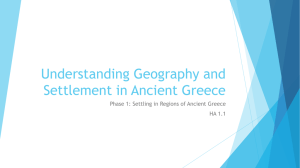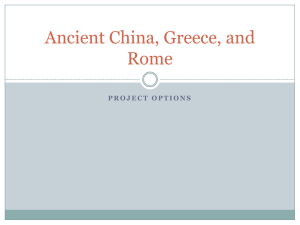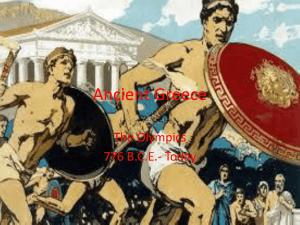Ancient-Lineage-Based - Mrs. Duvall Art History
advertisement
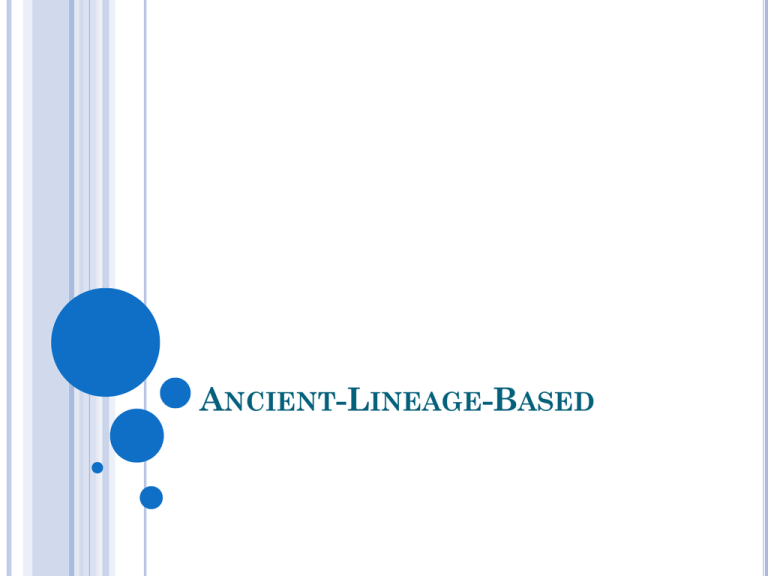
ANCIENT-LINEAGE-BASED 1.1 DANCE – AFRICAN AND NATIVE AMERICAN The purpose was to link the dancer to the tribe both alive and dead. religious ritual and social expression. Ceremonies, feasts, and special occasions. means of communication with supernatural forces. Honored the gods Included animals and nature DRAMA - ANCIENT AND LINEAGE-BASED ritual dances, storytelling, religious ceremonies and religious rituals. Centered around nature, family and tribal life. holy person would wear a mask made from natural materials, (bark, feathers, skins, skulls) Makeup-crushed berries, animal blood, sap, mud, or pulverized rocks. Dramas became educational about the world around them. MUSIC –ANCIENT AND LINEAGE-BASED The Gold Lyre of Ur, 2650 BC. Music were rituals, worship, and oral transmission of culture and traditions. Animism-that animals and inanimate objects in nature have souls Music imitates sounds in nature such as animal and birdcalls, wind, running water, and weather. EGYPTIAN MUSIC horns, harps, cymbals, and drums from ancient burial sites and Egyptian ruins. Music was a part of festivals, religious rituals, and war rallies. HEBREW MUSIC music for religious rituals, worship, and for entertainment. The Torah The first five books of the Bible's Old Testament Book of laws and earliest recorded history of Judaic culture. Says that priests performed chants in rituals 1.2 VISUAL ART - ANCIENT AND LINEAGEBASED Created visual impressions of surroundings. “Cave paintings” was an attempt at realism. Recreating the animal exactly as it appeared in real life Deer, bison, antelope, and mammoths. “Shadow Hands”, placing hand on the wall of the cave, blowing a staining powder over the hand and the surrounding wall, then removing the hand, leaving a perfect "shadow" of the hand. Used to educate members of early tribes on how to hunt. Brushes were made of split sticks; later the brushes were made of animal hair. Paints were made of crushed berries, ashes, and mud. Blowing through hollow animal bones, like a modern spray-gun ART OF THE AFRICAN NATIONS Masks, costumes, movements, and drum rhythms were distinct for each ceremony. Arts were used for teaching, celebration, praise of the deity, and commemoration of life events. THREE FACTS ABOUT ANCIENT EGYPT 1. 2. 3. to the Egyptians, the ruler (Pharaoh) was god on Earth there was a life after death the Nile River brought life to what was otherwise a barren desert. A Pharaoh's body would be well preserved because they would come back to reclaim it. Surrounded by wealth and items The pyramids were the tombs of the most important Pharaohs. The Nile River would flood each season bringing water to many people and crops needed to live EGYPTIAN ART The head is profile, body is three-quarters view. The content mattered Size could indicate the age of the person, or it could indicate the rank or social status. Mankind was the subject of drawings THE GREAT SPHINX Half lion, half human. Positioned so that travelers would see it as they approached the largest city on Earth at that time. The face is 13 feet wide; Pharaoh Khafre. The lion's body is 240 feet long and over six stories tall. Built about 2540 B.C KING TUTANKHAMEN Achieve little, died early Tut's burial mask, weighed over 20 pounds, measured over 20 inches high. The vulture and cobra are symbols that represent his rule over both Upper and Lower Egypt. Egyptians good at sculpting life-like figures. King Tut brainpop 1.3 GREECE AND ROME (800 BC-400 AD) Ancient Greece and Rome – They were concerned with creating ideal, wellbalanced citizens. Their idea of beauty involved simplicity, nobility, balance, and proportion. They conducted ritual worship to appeal to their gods and goddesses. Dance – Ancient Greece and Rome The only record we have of dance in Greece and Rome is found in vase paintings. We know that dance was included in drama productions as well. EGYPTIAN HERIOGLYICS http://flashnhistory.com/FlashPrograms/Glyphics .swf DRAMA/THEATRE -ANCIENT GREECE AND ROME Started religious grew more about re-telling history (tragedy) and how people should live (comedy). Roman theatre, the plays were completely secular (non-religious). In Greece, plays were performed in open hillside amphitheatre; good acoustics-(thirty-thousand people) Skene- roof covered the stage Proskenion the part not covered by the roof. Parados-side entrance and exits GREEK DRAMA Early Greek plays were chanted by choruses. Plays started with one actor on the stage in front of the chorus, over time more actors grew. All the actors, including the chorus, were men. Women could attend but not perform. At Greece’s popularity-tragedies Greece’s decline in power- comedies ROMAN DRAMA Storylines-domestic and romantic adventures rather than more serious topics. Roman theatre- blood and gore. No chorus “stock characters” with easily identifiable traits that could appear in different stories interchangeably. comic servant, foolish old man, and the quack DIFFERENCES Greeks Valued life Philosophy for fun Thinkers Drama No violence (drama) Romans Valued fighting Violence for fun Fighters Not much drama Violence (everything) MUSIC - ANCIENT GREECE Pythagoras- ancient Greek and mathematician thought math was important in creating a music scale Three purposes for music: to instruct, to inspire, and to alter mood. Music magical powers important part of life Musical competitions In dances and chorus of plays Believed it affected people’s character-(strictly regulated). MUSIC - ANCIENT GREECE Aristotle- music should lead a person to have noble thoughts. Doctrine of Ethos, the moral qualities and effects of music. Music directly influence a person’s mind, body and soul The lyre, a small, handheld harp, The aulos, a wind instrument; cross between the oboe and bagpipes 1.4 VISUAL ART -GREECE AND ROME Sculptures before Classical Greek times were very stiff, with figures either standing straight up or sitting down, the legs even, and the feet flat. THE DISCUS THROWER Classical Greek ideal of beauty. Physical perfection Contrapposto (creating an s-curve to the body by balancing more weight on one leg), to show movement Classical Greeks were able to achieve naturalism, or a lifelike appearance THE PARTHENON, 447 B.C.E The Acropolis in Athens, Greece Most perfect building in the world Persians bombed it in the 17th century against the Turks. Originally painted, Greeks like to paint their buildings A life-size copy is in Nashville, TN GREEK COLUMNS The Doric The Ionic The Corinthian THE DORIC Sometimes no base Vertical shaft is fluted Short than the others Capital has rounded molding THE IONIC Has base Shaft is fluted Taller and more slender Capital has spiral volutes THE CORINTHIAN Has a different base than ionic Shaft is fluted Slender and tall Capital is decorated like acanthus leaves ROMAN ARCHITECTURE perfected the arch keystone ROMAN AQUEDUCT ROMAN COLOSSEUM Third floor: pilasters Second floor: Corinthian First floor: Ionic Ground floor: Doric REVIEW OF THE TWO TIME PERIODS Ancient-Lineage Based Art work, music, drama and dance reflected a person’s surroundings. Used nature and religion in their performances. Egyptians believed in an afterlife and dressed Pharaohs' tombs. Greek and Roman Beauty, simplicity, nobility, balance, and proportion Amphitheatres, actors all men Music could alter a person’s behavior Art was realistic Architectural buildings had beautiful columns
